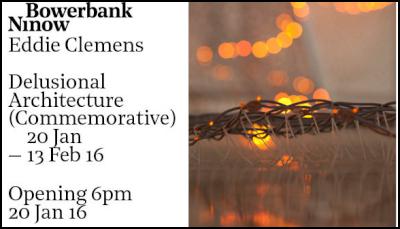Delusional Architecture Opening Wednesday 20 January at 6pm
Delusional Architecture (Commemorative), Eddie Clemens, Opening Wednesday 20 January at 6pm

Eddie Clemens knows that these walls were custom built for the display of huge paintings. He has aggressively intervened into this architectural setting with thirteen two by two metre fences woven from electrical wire and conduit piping. The walls form a fortification or barrier, physically demarcating action and experience. Barriers are often placed in front of paintings hanging on this wall. Here they push painting out, compromising the medium’s promise of a window onto another world.
Yet Clemens’ practice is based on subverting the functional or use value of utilitarian objects. The fence has already collapsed, or been broken through. Traces of Gordon Matta-Clark’s ‘anarchitecture’ and Lucio Fontana’s slashed paintings can be felt here, but the primary reference point is a scene in James Cameron’s film Terminator 2 (1994). In this film the T-1000 materialises from the future by breaking through a chain mesh fence, leaving a smoking circular void. Clemens’ sculpture replicates this film prop, down to the use of a programmed cycle of LED lighting to simulate the molten metal wire ends. As in the film, Clemens’ sculpture fails as a fence that divides and maintains order. It becomes instead a dematerialised gateway or portal that facilitates escape and escapism, qualities more often invested in painting, film or science fiction than sculpture.
This blurring of the utilitarian object with the art object carries over intoSecond Generation fibre optic broom #1. Glowing icon-like on its rack, this hi-tech broom bristles not with dust, but with the accrued energies and resonances of the gallery space which Clemens swept in an unseen performance during the installation period. This second generation technology pulses with text as well as colour, talking to a legacy of sculptural practices that reaches well beyond this gallery. German artist Joseph Beuys’ sweeping of the streets of Berlin with a bright red broom in 1972 challenged the conventional boundaries of sculpture by signalling a move away from objects into actions. With his futuristic broom Clemens has found a way to hold action and object in productive tension, while putting art to work.
ends


 Universities New Zealand - Te Pokai Tara: Young Mathematics Talent Bound For Cambridge With Sir Douglas Myers Scholarship
Universities New Zealand - Te Pokai Tara: Young Mathematics Talent Bound For Cambridge With Sir Douglas Myers Scholarship Yachting New Zealand: NZ Windfoil Star Starts New Olympic Campaign With Bronze At Princess Sofia
Yachting New Zealand: NZ Windfoil Star Starts New Olympic Campaign With Bronze At Princess Sofia E tū: Bupa Roster Changes Put Residents And Caregivers At Risk
E tū: Bupa Roster Changes Put Residents And Caregivers At Risk Democratic Voice of Burma: The Resilience And Hope Of Myanmar’s People On Screen In Auckland Sat April 5
Democratic Voice of Burma: The Resilience And Hope Of Myanmar’s People On Screen In Auckland Sat April 5 NZSEG: Powering The Future - NZSE College And Royal New Zealand Navy Forge Educational Partnership
NZSEG: Powering The Future - NZSE College And Royal New Zealand Navy Forge Educational Partnership Courtney Duncan: Illness Prevents Duncan From Contesting First Round Of 2025 World Women’s Motocross Championship
Courtney Duncan: Illness Prevents Duncan From Contesting First Round Of 2025 World Women’s Motocross Championship